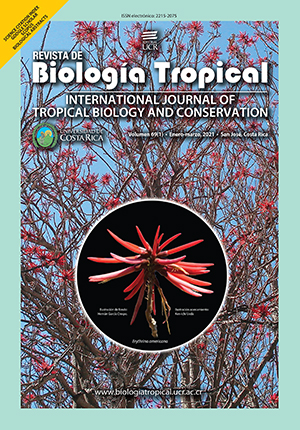Resumen
. Introducción: La migración desde ambientes rurales hacia las ciudades ha acelerado la urbanización. Esto ha modificado el paisaje, así como los procesos ecológicos y comunidades dentro de estas áreas. El Pinzón Cafetalero (Melozone cabanisi) es una especie de distribución limitada restringida al Gran Área Metropolitana, que es el asentamiento urbano más grande del país. Esta área ha experimentado, y continúa, fragmentación y pérdida del hábitat utilizada por esta especie (e.g. plantaciones de café, charrales y tacotales). Objetivo: Determinar los efectos de la urbanización sobre la cantidad de hábitat y su patrón espacial para la ocurrencia de M. cabanisi. Métodos: Modelamos el área del hábitat potencialmente adecuad para M. cabanisi utilizando datos bioclimáticos y de ocurrencia. Luego estimamos el hábitat verdaderamente adecuado utilizando el hábitat potencialmente adecuado y las capas de cobertura del suelo. Finalmente analizamos la conectividad entre los parches de hábitat verdaderamente adecuados utilizando un enfoque multi y mono-parche. Resultados: Del área del hábitat potencialmente adecuado estimada por el modelo bioclimático, 74 % fueron áreas urbanas, una cobertura inadecuada para M. cabanisi. Los parches más grandes de hábitat adecuado dentro de áreas urbanas fueron plantaciones de café que a su vez fueron cruciales para mantener la conectividad entre los parches a lo largo del rango de distribución de la especie. Conclusiones: Para conservar y proteger a M. cabanisi, los tomadores de decisiones deben tener en cuenta estas áreas en los planes de gestión presentes y futuros. Recomendamos evitar cambiar charrales y tacotales a tipos de cobertura urbana para preservar la ocurrencia de M. cabanisi e implementar un programa para el pago de servicios ambientales a los propietarios de tierras, con el apoyo de los gobiernos locales y proteger esos hábitats en contextos urbanos. Finalmente, esta es una herramienta que ayudará a detectar qué hábitats dentro de áreas altamente urbanizadas son los más importantes para garantizar la conservación de diferentes especies.
##plugins.facebook.comentarios##

Esta obra está bajo una licencia internacional Creative Commons Atribución 4.0.
Derechos de autor 2021 Pablo Muñoz, Adri´án García-Rodríguez, Luis Sandoval



